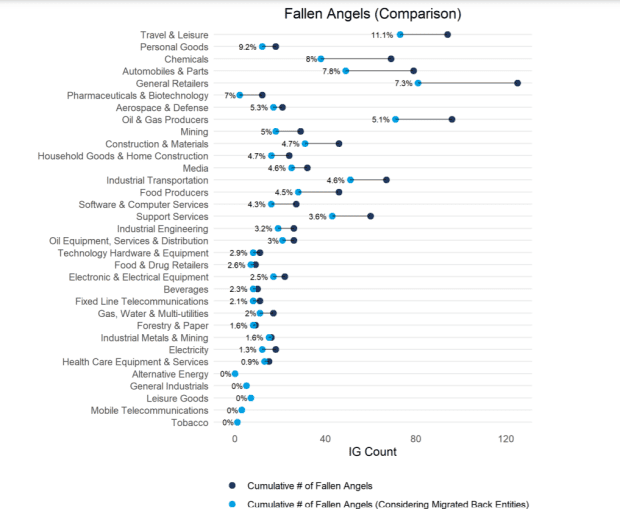The COVID-19 pandemic has not only been disrupting lives and businesses around the world for more than a year, but also the credit ratings of big corporations.
Corporate credit ratings serve as a key measure of creditworthiness, but also can determine borrowing costs. They range from AAA for top-notch companies like Johnson & Johnson JNJ, -0.39% and Microsoft Corp. MSFT, +1.34% to D for defaulted businesses.
Increasingly, credit ratings also can signal a potential path to recovery for industries hard-hit by the prolonged public-health crisis.
Take travel and leisure, a sector that saw half of all investment-grade companies globally drop to high-yield, or “junk,” status during the pandemic, according to a new report from Credit Benchmark.
Even as parts of Europe remain in a lockdown to contain the coronavirus, travel and leisure has experienced the highest share of “fallen angels” (at 11.1%) returning to investment-grade status during the crisis, (see chart below).

Fallen angels, rising stars
Credit Benchmark
The report identified 1,051 fallen angels out of 6,895 companies it sampled globally, or about 15% of the total. It found that about 5% migrated back to investment-grade.
Retailers, oil and gas, and the automobile and parts sectors also were volatile on the credit-ratings front in the past year, according to the report, with migrations between the two major brackets now a key focus for investors.
Read: The next rising stars of the debt world? Probably corporate fallen angels
Upgrades and downgrades can make a big difference for a company in terms of its borrowing costs. The average yield on bonds issued by U.S. investment-grade companies now sits in the 2.21% range, whereas it’s nearly double for those in speculative-grade territory at about 4.21%.
Those rates matter, particularly in the past year as cruise companies, including Carnival Corp CCL, -1.52%, Royal Caribbean Group RCL, -1.37% and Norwegian Cruise Line Holdings Ltd NCLH, -2.20%, have borrowed billions as their ships largely have been idle.
See: White House pushes back on cruise industry’s efforts to restart in July, as Florida sues Biden administration
But along with other “recovery” trades, shares of Carnival were up 31.9% year to date Thursday, while those of Royal Caribbean and Norwegian were up about 20%, according to FactSet data.
That compares with the Dow Jones Industrial Average’s DJIA, +0.17% gain of 9.5% for the same period, while the S&P 500 index SPX, +0.42% has advanced 9.1%.
